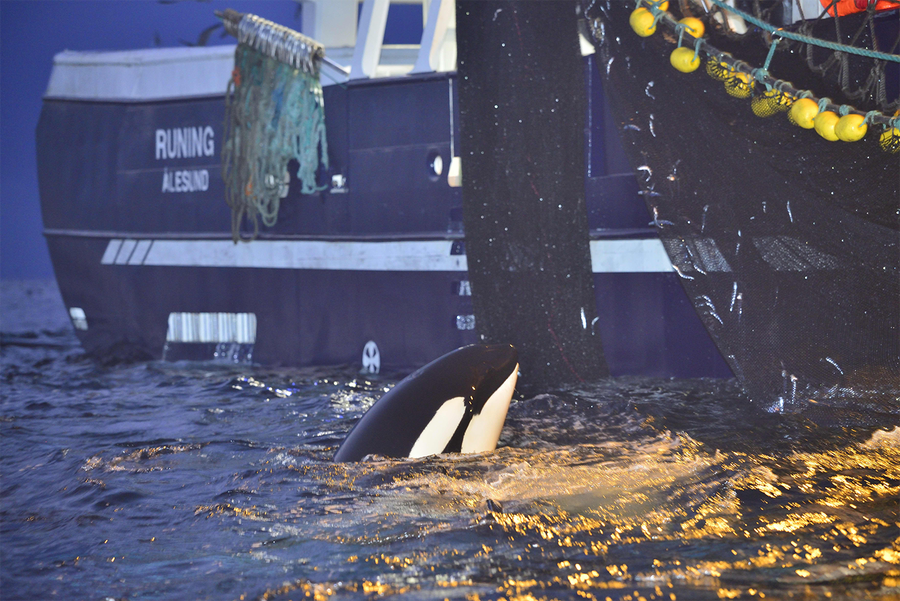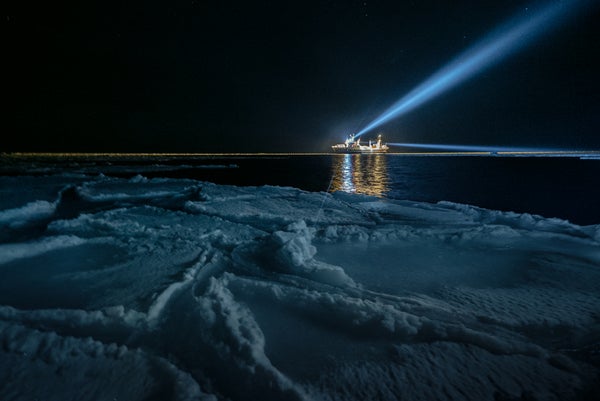As sea ice in the Arctic Ocean dwindles with each successive year of rising global temperatures, it has become easier and more common for companies to venture into the region for fishing, shipping, and oil and gas exploration. Though the boats, rigs and other trappings of human activity have already quickly moved into this fragile environment, scientists are only just beginning to understand how the light, sound and chemical pollution they bring with them is impacting the Arctic’s marine ecosystem.
Some researchers have started filling in the gaps, including two teams working in Norway that presented new findings about the behaviors of zooplankton and killer and humpback whales at the Arctic Frontiers 2020 conference in the nation’s city of Tromsø in January. Though zooplankton may seem to have little in common with whales, research shows that creatures at both extremes of the Arctic food web are critical to the health of the marine ecosystem. Understanding how industry affects these animals could help inform policies governing commercial activities in the Arctic.
Light Sensitivity
On supporting science journalism
If you're enjoying this article, consider supporting our award-winning journalism by subscribing. By purchasing a subscription you are helping to ensure the future of impactful stories about the discoveries and ideas shaping our world today.
Tiny zooplankton move in response to light cues during the day. When the sun rises in the morning, they drift down closer to the seabed to avoid predators. When the sun sets, they ascend toward the surface to feed. During the 24 hours of darkness occurring in the Arctic winter—a nearly month-long period called the polar night—scientists had thought zooplankton simply stopped moving under the sea ice, says Jørgen Berge, a taxonomist and marine biologist at UiT–the Arctic University of Norway.
But that thinking changed after the winter of 2007–2008, when Berge noticed that zooplankton in the fjords of the Svalbard archipelago were still moving up and down in patterns similar to the ones they followed when the sun shone. He found they could still sense and respond to low levels of light from the moon, the aurora borealis and background illumination from the sun—even under thick layers of ice and snow. “It was a complete surprise to us,” Berge says.
In subsequent work, he showed that other Arctic denizens, such as shrimp, krill, herring and cod, would also respond to light levels that were orders of magnitude lower than the ones similar species experience in waters elsewhere around the world. This left him concerned that Arctic animals would be extra sensitive to artificial light and that exposure to it could change important aspects of their behavior. Such light pollution, which shines with an intensity and composition not found in nature, has been shown to disrupt the hormone production and metabolism of many vertebrate species, including fish—and humans.
To investigate, Berge monitored how Arctic animals moved in response to the artificial lights from just one ship: his own research vessel. In three locations during the polar night of 2019, Berge measured the total mass of the marine animals around the ship with the lights on and off. In each case, there was a significant difference. At one location, there were about half as many animals around the ship when the lights were switched on. In another, with a different animal population, the biomass increased with the lights on—a response Berge says is not surprising, because, like moths on land, some marine animals have adapted to be attracted to light instead of repelled by it.
This research, published Thursday in Communications Biology, has strong implications for the fishing industry, Berge says. Norwegian authorities currently gather information about the abundance of fish in the area throughout the year, including during the polar night, and use that information to determine fishing limits. But because these assessments are carried out with artificial lights on, “that could have a strong bias,”Berge notes. “Our ability to measure and understand and make good predictions as to how much you can fish could be based on wrong input data.”

Killer whale near a fishing boat in the Arctic Ocean. Credit: Evert Mul
Likewise Berge believes that no scientific study that has ever been conducted during the polar night—with lights turned on—could be considered an unbiased representation of how the animals would naturally behave during that time. “In darkness and light, you will get two very different results, and the knowledge about the system will be very different,” Berge says. Franz Hölker, an ecologist at the Leibniz Institute of Freshwater Ecology and Inland Fisheries in Germany, who studies light pollution but was not involved with the new work, agrees. He says Berge’s findings mirror some of his own.
Safety concerns for humans make it impractical to ban artificial light in the Arctic altogether, Berge says. “Rather we need to understand what effects light pollution is causing.” That way, the level of bias in scientific studies and fishery estimates could be quantified and, to some degree, corrected.
Where the Whales Are
The need for more knowledge of human industry’s effects exists on the other end of the Arctic animal size scale as well. Though fishing, shipping, and oil and gas activities have expanded rapidly in the Arctic, “we have no idea what the whales are doing,” says Evert Mul, a Ph.D. student at UiT. “We plan those activities without taking into account the presence and the distribution and the behavior of the whales.”
To help change that situation, Mul and his colleagues at UiT and the Institute of Marine Research in Norway have tagged 45 killer whales and 30 humpback whales over the past seven years—many more than in previous tagging studies. Doing so allowed them to map how these whales interact with the human activities taking place in polar regions for what they say is the first time ever in this part of the Arctic.
Mul says the team’s results, which he expects to publish this summer, show the whales spent significant amounts of time in the locations where there was heavy shipping traffic, as well as oil and gas installations. “And of course, they spend a lot of time near fishing vessels,” because they are drawn to the massive amounts of fish the commercial boats collect, he says. It is not uncommon to see anywhere from 50 to 100 whales around a single vessel, Mul adds. Attracted to such a concentration of these spectacular animals, boats filled with tourists join the action, too.
Greg Breed, a biologist and associate professor at the University of Alaska Fairbanks, who was not involved with Mul’s work, has observed similar confluences in human and whale activity during his own studies in the Canadian Arctic. “They happen to overlap because they’re using the same space,” he says. For example, whales take advantage of the ice-free passages cleared by large vessels.
Though the whales may seem to benefit from easy snacks swiped while swimming near fishing boats, human activity may harm the animals, too. Many of the cetaceans tagged in Mul’s study have visible scars from entanglement with fishing nets or collisions with boat hulls or propellers. Noise pollution can interfere with the complex songs the creatures use to communicate, he says. Chemical pollution is another issue. Killer whales already have some of the highest contamination from polychlorinated biphenyls (PCBs) on earth, and modeling has demonstrated this problem could endanger the long-term survival of the Arctic killer whale population.
As Breed points out, though, it is also possible that stressors other than physical injuries or pollutants—such as interruptions to the marine food chain linked to warming ocean waters—could be having more of an impact on Arctic whale populations. Potential impacts, including those identified by Mul and Berge, should be considered when making decisions about industry in the Arctic, the researchers say. Like Berge, Mul believes the best course of action at this point is not to call for drastic bans but for policies that make obvious sense—such as better regulation of pollutants where whales are more abundant. Mul also stresses the need to continue improving the information scientists have about the magnitude of the problem.
Even with limited knowledge, those who are planning industrial activities in the Arctic still need to be aware of the possibility that their presence could have repercussions, Mul says. He would like industries to at least “have the seasonal whale distribution in the back of their mind, even while we are still continuing to understand, and to map, the situation.” To help with this effort, Mul plans to hold a meeting with Norwegian industry leaders to inform them of his results and seek feedback about how he can present the information in a way that is useful to them. “It's very important,” he says, “to have at least a basic understanding of what the animals are doing that we are going to share this region with.”
